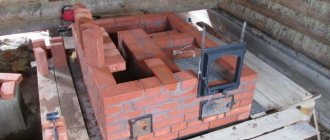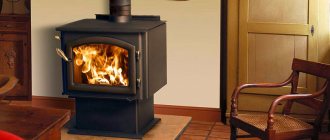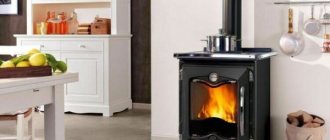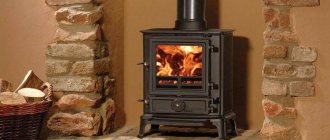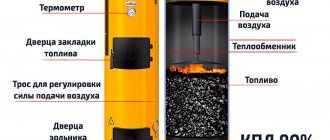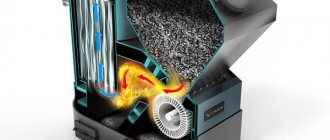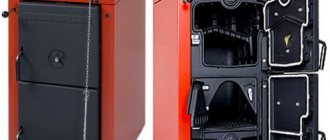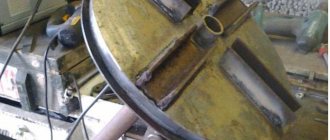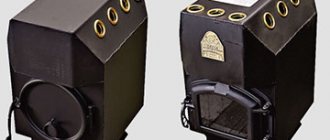Design features of coal furnaces
If you look closely at a coal stove and its most common wood-burning competitor, then, in principle, it will be difficult to find any special differences at first glance. But upon closer examination and familiarization with the operating principle of the furnace itself, it becomes clear that they differ fundamentally. (See also: Do-it-yourself housekeeper oven)
- The principle of combustion and air supply differs; if for wood-burning stoves the most efficient combustion can be achieved when air is supplied directly to the place of fuel combustion from above, then for coal stoves it is necessary to purify the fuel and supply the air mixture from below.
For wood-burning stoves, the use of dry fuel during the combustion process is not particularly critical. It is only important that the initial lighting of the stove occurs with dry material. Before adding coal to the furnace, it is advisable to preheat it in a special compartment of the furnace, which is heated by exhaust gases.
The design of the chimney for a coal-fired stove is somewhat different from its wood-burning counterparts and is designed for a higher air flow rate. And the flow itself and its speed are regulated not by a blower, but by a blower. The damper itself, blocking the chimney (yushka), is completely absent. This feature is due to the fact that coal stoves smolder for a very long time, and do not quickly burn through fuel like wood stoves. The disadvantages of coal stoves are also associated with this feature:
- It is impossible to block the chimney to prevent the weathering of heat due to the danger of carbon monoxide poisoning, and therefore coal heating stoves cool down quite quickly.
- For normal combustion of a coal furnace, it is advisable to exclude the presence of combustion products in its lower compartment. To do this, it is necessary to periodically clean the ashpit, which will be constantly replenished with burnt coal. In this case, cleaning must occur more often than is necessary for a wood stove.
The walls of coal stoves must withstand higher temperatures than conventional wood stoves; accordingly, they will be thicker, and more heat-resistant materials must be used for their assembly.
(See also: DIY camp stove)
A coal stove may have a special design for loading fuel, this is due to the higher ignition temperature of coal - that is, it will not be possible to light such a stove with just a piece of newspaper and matches. Therefore, in a coal stove, firewood is first lit, and coal is loaded on top, which gradually flares up as the wood burns out.
In practice, combination stoves are often used, in which both coal and wood can be burned simultaneously. In addition, peat briquettes, which burn very much like coal, can also be used as fuel. In combined devices, all elements of both a coal and wood stove are simultaneously present.
Best models
Let's look at the best factory-made models, and then move on to making a coal stove with your own hands. These models are suitable even for a large country cottage. You can buy them on the manufacturer’s website by submitting an online application.
| Name and price (RUB) | Characteristics | ||||
| Room area m2 | power, kWt | Dimensions, mm Chimney, mm | Weight, kg | ||
| Zota stakhanov 100, from 370000 | 1000 | 100 | 900x1608x1796, 800 | 880 | |
| Teplov T-100, from 185000 | 1000 | 100 | 1770x810x810, 250 | 900 | |
| Vulkan EKO-100, from 330000 | 1500 | 100 | 1770x810x810, 250 | 900 | |
| “Bourgeois-K” T-100A-2K, from 272000 | 1000 | 100 | 780x1420x1890, 250 | 900 | |
| Ferroli Forest 100, from 1200000 | 1000 | 115 | 2898x4533x2700, 200 | 1230 | |
Coal
Coal is a traditional raw material for solid fuel boilers. It burns for a long time and has good heat transfer, but only if it is correctly placed in the combustion chamber, properly ignited and subsequently maintained.
Coal selection
To increase the efficiency of the boiler and extend its service life, it is necessary to take into account the manufacturer’s recommendations for choosing the grade of coal. Usually the name of the brand and its fraction are indicated in the technical data sheet of the device. Each grade has a different ratio of carbon and impurities, different humidity, structure, strength and age of formation.
The most popular types of coal for solid fuel boilers:
- Coal. The heat transfer of the fuel is 5500 kcal/kg. The average percentage of carbon and ash is 75%/3%. Suitable for igniting most classic boiler models.
- Anthracite. Specific heat indicators are 9000 kcal/hour. The percentage of carbon is no more than 7%. The disadvantage of this variety is difficulty in ignition and extremely high combustion temperature.
The most popular and convenient for ignition is long-flame coal. This universal fuel for all types of boilers ignites quickly, burns for a long time and releases a large amount of energy.
Brown coal and lingite can be found on sale. However, these varieties are recommended for use only on an industrial scale due to the large amount of ash residue and high humidity levels.
How to fire a boiler with coal
The solid fuel installation consists of two main chambers: the upper one is used to store fuel, and the lower one (ash pan) is used to collect ash and slag. As the fuel burns in the main chamber, the combustion products gradually fall into the ash pan, from where they are removed manually.
Before starting melting, it is necessary to prepare the installation for operation. To do this, solid combustion products are removed from the ash pan, the walls of the combustion chamber are wiped and the chimney channels are cleaned.
As soon as the preparatory work is completed, you can begin loading fuel and igniting.
- Place dry paper on the grid of the main chamber. It is recommended to crumple it up first - this way it will light faster.
- Place wood chips and brushwood evenly on top in the shape of a well or hut.
- Light a match and bring it to the paper from different sides - the paper will burn evenly, involving wood chips in the process.
- Close the firebox door and open the ash pan valve to allow oxygen to enter. At this stage, you will have to monitor the combustion process of the wood chips. You can adjust the intensity using the ash pan (ash pan) door.
- As soon as the wood chips burn completely, pour a small layer of fine coal on top. Its amount should not exceed a third of the combustion chamber.
- After loading the first batch of coal, close the door again to achieve maximum combustion temperature. This usually takes about
- When the first layer of fuel completely engulfs the flame, add the remaining coal to the upper border of the door. It is recommended to stir the burning coal slightly beforehand.
- Close the blower door halfway. If there is strong smoking, leave a small crack.
As combustion proceeds, fuel is added in small portions to the main chamber, each time closing the ash pan damper. You should not put in a large amount of coal at once - this will lead to the fuel solidifying on the grate and its premature deterioration.
Firewood
Firewood is another popular type of fuel for boilers. Only dried wood is suitable for burning. Under-dried firewood in the firebox begins to release moisture, which accumulates on the internal surfaces of the firebox and chimney. In combination with smoke and carbon monoxide, tar is formed - it reduces the operational properties of the boiler and reduces the permeability of exhaust gases.
Firewood selection
For melting, hardwood with a long burning life and slow heat transfer is optimal. Preference should be given to deciduous trees over coniferous ones. During the combustion process, conifers emit a large amount of resinous substances and quickly pollute the combustion chamber and heat exchanger.
According to the degree of hardness, wood species are divided into 3 categories:
- hard - white acacia, ash, beech, oak, maple, yew, hazel, pear;
- medium hard - walnut, alder, sycamore, birch, cherry, cherry, cedar;
- soft - poplar, aspen.
How to heat a boiler with wood
- At the first stage, it is necessary to warm up the heating device well. This will prevent smoke from leaking into the room. Sheets of paper are placed at the bottom of the fuel chamber, on them are flammable birch bark, chips and splinters, and on top are small logs (up to 15 cm in diameter). The space between the chips can be filled with paper for faster ignition.
- When the firebox is about half full, you should set fire to the paper and open the ash pan valve for better draft. Close the main chamber door.
- When the chamber and chimney warm up and the preparatory filling begins to burn out, the firebox can be filled with large firewood. You can lay out the logs in a row or in the form of a well, leaving gaps between them for air penetration.
- As the firewood burns out, you will need to make a new stack without waiting for the previous one to die out.
Long-burning boilers greatly simplify the work. Fuel is added to them once every 6 hours due to automatic regulation of draft and combustion process. Such devices should be melted in accordance with the attached instructions.
How to calculate coal consumption
Coal consumption in a solid fuel boiler depends on many factors. Costs are affected by:
- Heated area.
- Amount of heat loss.
- Ambient temperature.
Exact costs can only be calculated after the end of the heating season. Moreover, depending on the winter, the average consumption of coal for heating can vary from 8 to 15 tons (for a building of 200 m²).
If you make average calculations based on actual operating experience, you can obtain the following data:
- Costs for September – October will be 1 bucket per day.
- Fuel consumption rates in a coal boiler from November to February will increase to 10 buckets per day.
- In March and April, you will need to burn 1-2 buckets per day.
Calculating the coal consumption for a 20 kW boiler, using the above data, will show that the costs during the heating season will be 580 buckets or 10-10.5 tons.
Advantages and disadvantages
This solution has obvious advantages:
- the oven can operate offline for up to 10 days;
- the operating time on one load of fuel increases by 2 times for firewood, and by 3 times for coal;
- low requirements for fuel quality;
- simplicity of design and installation;
- the ability to add additional options.
But practice has shown that there are also disadvantages:
- it is impossible to add fuel until the previous fuel is completely burned;
- you need a dry place to store fuel;
- coal produces a lot of dust and soot;
- high fire hazard if the requirements of SNiP 2.04.05-91 are not followed;
- The ash pan must be cleaned after each firebox, and the chimney before each heating season;
- environmental pollution.
How to do it yourself
- The design of a brick stove burning coal or briquettes is quite simple; you just need to meet two conditions:
the firebox must be made of refractory bricks; The stove must be equipped with cleaning systems in all areas of the chimney.
The ordering diagram of a universal oven is shown in the figure. Thanks to a simple device, you can do it yourself, even without experience. The stove is small in size and can be used to heat a country house or village house with an area of up to 36 square meters, consisting of one or two rooms. In the latter case, the firebox is located on the kitchen side, and the back wall, which heats up during the fire, is brought into the room.
The stove consists of a firebox, lined with your own hands from refractory fireclay bricks, and a firebox channel with one cover.
Flue gases are retained in the channel, a cap effect is created, and the furnace body warms up. After cooling, the smoke descends and exits through the chimney. It is equipped with two valves that eliminate sharp boundaries between warm and cold air and moisture condensation.
Below the firebox there is a ash pan combined with an ash pan. Pressurization is carried out through a grate; air movement is ensured by a simple chimney design and good draft.
- The furnace is installed on a free-standing foundation made of reinforced concrete. The dimensions of the foundation should be 5-10 cm larger than the dimensions of the furnace, its height should be 50-70 cm, and it should be 15 cm below the level of the finished floor covering. After the foundation has been poured and dried, it is leveled with cement mortar, two layers of roofing felt or other rolled waterproofing are laid on it, after which they begin laying the furnace with their own hands.
- They lay out two rows of brick - the base of the stove, in solid masonry with a bandage of red brick. They are placed on cement mortar.
- Next, the masonry is carried out in accordance with the diagram using a solution of fireclay clay. The first row forms the bottom of the ash pan.
- In the second and third rows, place the blower door, securing it with annealed wire placed between the bricks.
- The fourth row forms the overlap of the ash chamber and an opening for blowing and removing ash from the firebox.
- Starting from the fifth row, the laying is done with fireclay bricks. A grate is laid in the fifth row.
- In the sixth and seventh, the firebox door is installed in the same way as the blower door.
- Rows 9 to 11 form the walls of the firebox; they are placed with a bandage.
- In the 12th row, a vault is made from ¾ of the brick, and in rows 13 and 14, the vault is covered.
- In the 15th row, a cleaning door and a cover are installed.
- Starting from the 16th row, the masonry is again made of red brick. Smoke channels are laid out according to the diagram.
- Valves are installed in rows 25 and 32.
- Rows 33 and 34 complete the overlap of the stove, then lay out the chimney of the required height.
- The stove is dried in air, then carefully heated in multi-steps, first with wood, and after several fireboxes - with coal. During operation, it is allowed to use any solid fuel: coal, anthracite, firewood and wood waste, pellets and briquettes.
Any metal stove with a long-burning effect can be used to fire coal. by laying out a fireclay brick lining in the firebox with your own hands and equipping the vent with a fan. With this modification, the metal of the furnace will not burn out from high temperatures, and the coal will burn steadily for a long time.
Power selection
The description of a metal fireplace stove must indicate the heating area it is designed for. When choosing power, it is better to take a margin of about 15-20%. This is to prevent the body from overheating even on the coldest days. It quickly burns out in this mode.
The power of the fireplace stove is selected with a small reserve - for the coldest days
On the other hand, you shouldn't take too much stock. Solid fuel stoves and fireplaces are difficult to regulate in temperature. And, if the power of the heating equipment is many times greater than necessary, the room will be too hot when firing. Nothing can be done about it. If the power is too high, even in smoldering mode there may be too much heat.
So, when choosing the power of a long-burning fireplace stove for a summer house or home, we take it with a margin of 15-25%. For example, the heated area is 100 sq.m. A suitable metal fireplace should have the ability to heat 115-125 square meters.
Video review of the Kratki Koza K9 stove-fireplace.
Homemade potbelly stove
Recently, many designers have been offering exclusive versions of potbelly stoves or fireplace stoves that are installed in country houses. For residents of prestigious cottages, they are not only an additional source of heat, but also a beautiful accessory for the interior design of the room. Such individual stoves fill the room with warmth and special comfort. Firewood crackling in a stove or fireplace looks very beautiful and romantic when a winter blizzard is raging outside the window.
The most popular, primitive and effective long-burning stove for temporary heating is the well-known potbelly stove. Its simple design is based on the “symbiosis” of a Russian stove and fireplace. With one load of fuel, it is capable of maintaining a comfortable indoor temperature for 4 hours. The potbelly stove can be installed in any space where a chimney can be removed.
Today, anyone who has the skills to perform plumbing work can make a potbelly stove with their own hands from all kinds of available materials. This oven:
- Does not depend on electricity or gas.
- Easy to maintain and operate.
- Allows you to control the combustion process.
- Takes up little space.
- Compact and economical.
- May have a hole for installing utensils to cook food or heat water.
Among the disadvantages of such a furnace, it should be noted the low efficiency, high speed of exhaust gases and rapid cooling. Therefore, to maintain the temperature in the room, it must be heated constantly.
The following can be used as fuel for a potbelly stove:
Materials and equipment for independent work
Our craftsmen make potbelly stoves with a welding machine on hand and used:
- large cans;
- metal corners;
- wide pipes;
- gas cylinders;
- metal boxes;
- large fire extinguishers;
- old barrels;
- steel sheets;
- chimney pipes;
- metal gratings.
For ease of work, you can also use factory-produced technical fittings in the form of:
Main elements of the combustion unit
Detailed drawings are not needed to make a potbelly stove. The main thing is to get the most efficient design possible. Let's look at the main components that make up a homemade stove.
Combustion chamber
It is the combustion chamber that performs the function of heat transfer. The larger the outer surface area, the better.
It is important that the bottom of the chamber has sufficient area to place firewood or coal there. Therefore, cylindrical homemade devices are placed on their sides
Rectangular ovens are designed in a horizontal design with a minimum size of 250x350 mm.
Large stoves made from barrels or gas cylinders are also practical in a vertical position.
Type of finished product
An additional ash pan welded or screwed to the bottom of the structure is convenient for selecting ash. Its arrangement with a blower promotes better heat generation, and the lower door ensures the supply of the required amount of oxygen and regulation of combustion intensity.
Doors and openings
These elements are made with your own hands from the leftover metal after cutting out the openings. After all, the scraps from the cylinders repeat the bend of the surface, and this is very important in work. Steel door canopies are attached to the body by welding, and then the doors themselves are hung on them.
Here it is necessary to provide a locking device, which can be made like a guillotine bolt or bolt.
The optimal openings for the firebox have dimensions of 250x250 mm, for the blower - a height of 100 and a width of 250 mm. Canopies are installed on one vertical axis. A distance of approximately 10 centimeters is maintained between the openings. To prevent coals from falling out of the door, the firebox opening is located slightly above the level of the grate.
To remove flue gases in a potbelly stove, a steel pipe with a diameter of 100–150 mm is used. The pipe itself is not insulated - it serves as an additional source of heat. And for better heat transfer, it is placed towards the outlet with inclined or horizontal sections, thereby increasing the path of warm gases.
The outlet pipe for connecting the chimney is located on top or, preferably, on the side. The latter option slows down the removal of gases, leaving space for the cooking zone.
Note! In the chimney, to regulate the intensity of removal of hot gases, it is advisable to use a rotary or guide valve
Types and varieties
A long-burning stove-fireplace can only be of a closed type, because only if there is a door (also a sealed door) is it possible to regulate the oxygen supply, which is necessary to switch the unit to a long-burning mode. Specially designed fireplace stoves differ from conventional heating stoves in the geometry of the firebox: it is wider, the window usually has a horizontal orientation (although there are also vertical models). The stove door is usually made almost the entire width of the facade, which makes it possible to admire the flames.
Wall and corner models of fireplace stoves
According to their design, fireplace stoves can be wall-mounted (linear) or corner. Wall-mounted ones have a flat back wall and are installed at a distance of at least 2 meters from the corner. Corner ones are specially designed to be installed in a corner. But when installing them, the walls to which the housing is adjacent must be fireproof.
There is also a special model of fireplace stoves - three-sided. Only the back wall is made of metal, the other three are made of glass. Such options are very decorative; the flame can be observed not only opposite the door, but also from almost anywhere in the room. They can be installed against the wall, like ordinary linear ones (Neman, Volga, Angara), there are corner options (Amur and Louvre), but the most interesting are built-in models with three all-glass walls, for which they even make special partitions (from the German company Hark).
A specially designed firebox allows you to admire the flames from anywhere in the room
Very unusual fireplaces are produced by the German company Hark - glass, three-walled
There are also our three-wall metal fireplaces: Volga, Angara, Neman
Corner models of 3 side fireplaces: Amir and Louvre
And such options in German version
If we talk about the practical component, it is useful if the long-burning fireplace stove for a summer house has burners in the upper part on which you can heat/cook food. In a dacha setting, this is a very useful option. There are also metal fireplaces with ovens, but they are unlikely to support long-term burning.
There are models with a heat exchanger. This version of the fireplace stove is for a permanent home. Radiators are connected to the heat exchanger and a complete water heating system is built. It’s just that instead of a traditional heating boiler, a metal fireplace stove with a heat exchanger is used. This option is suitable for small buildings, since very powerful fireplaces of this type cannot be found.
Modern coal stoves for home description, types
A coal stove for the home has many advantages. The main ones are ease of operation and maintenance, the possibility of using another type of solid fuel instead of coal, and high heat capacity. And besides, such a coal-heated stove for a country house can be made of different materials.
A coal stove has high efficiency levels (about 60 percent, which corresponds to boilers for heating systems that use liquid fuel). Modern models allow you to control the combustion of coal in the furnace and regulate this process for a more rational use of fuel and heat.
Modern coal-fired stoves come in several types, depending on their purpose:
- heating stoves;
- heating and cooking stoves;
- household;
- stoves-fireplaces.
Modern stoves are made from different materials: refractory brick, cast iron, steel, soapstone, etc.
Is it possible to heat with coal?
Many owners of stove-heated homes are wondering: is it possible to use coal instead of firewood in a brick stove? Will it burn as efficiently as in industrial boilers?
The process of coal combustion occurs with the release of a large amount of heat; the temperature in the firebox is much higher than when burning wood. At the same time, the smoke coming out of the firebox is less hot than when burning wood.
For this reason, a conventional stove with long smoke channels cannot be fired with coal: the smoke entering the chimney will have too low a temperature, which will lead to the formation of condensation and soot. When they interact, they form carbonic acid, which destroys the bricks, which can ultimately cause a fire.
In addition, increased temperature in the firebox can cause its destruction. The firebox for a coal stove made of bricks must be made only from fireclay bricks, and the walls of the stove in this place must be thicker for high-quality heat removal and accumulation.
It is not recommended to burn an ordinary Russian stove with coal. having an unlined firebox and extended smoke channels! This will lead to the gradual destruction of the oven elements!
Other types of boiler fuel
Alternative types of fuel can be used to operate a solid fuel boiler.
Coal briquettes. The fuel is produced by pressing small fractions of coal and coal dust. They use minerals or coal tar as a binder. The advantages of this type of fuel are ease of installation and kindling, high calorific values and excellent flammability.
Pressed peat or wooden eurobriquettes. Fuel briquettes made from peat have a small area, but are capable of smoldering for a long time, maintaining the active combustion phase.
Pellets. This is biofuel made in the form of granules. Peat, wood and agricultural waste are used for production. This is an environmentally friendly and energy-efficient material, which is preferable to use in boilers whose design is adapted to pellets.
How to choose
Advantages of long-burning steel boilers:
- one-piece welded structure, not subject to leaks;
- rapid heating and cooling of the boiler walls and heat exchanger;
- Full automation is possible due to low inertia;
- less weight;
- reasonable price.
Disadvantages of steel models:
- susceptibility to corrosion, especially in welding areas;
- steel boilers cannot be repaired; in case of through corrosion and leaks, the unit is replaced with a new one.
The advantages of long-burning cast iron boilers include:
- resistance of cast iron to corrosion;
- the design of the heat exchanger from separate sections allows for partial replacement in case of damage;
- cast iron is a brittle and non-plastic material; in the event of a sudden change in temperature, cracks and destruction are possible;
- higher price than steel models;
- cast iron boilers are much heavier - 1.5-2.5 times.
Load volume and automation The frequency of filling the combustion chamber with coal depends on this characteristic. It is worth analyzing whether it will be convenient to load coal several times a day, or whether it is better to give preference to models with a large loading volume. The record holders for operating time are top-burning shaft-type boilers. They occupy a small area, while their loading chamber is quite large, and some models can heat a house for 5 days on anthracite and 3 days on brown coal on one load. Mine boilers are usually equipped with microcontrollers, which make it possible to automate the entire process and reduce maintenance to a minimum. Bottom-loading boilers, as a rule, are equipped with a smaller firebox, and they are much cheaper than mine boilers and are easier to use. Such boilers usually do not have a blower fan, and air flow occurs due to draft. The chimney for such a boiler should be as simple as possible and have a total length of no more than 5 meters. The advantages of boilers without draft are independence from electricity and low price. Disadvantages - low level of automation. Fully automated models with a loading hopper that can hold a multi-day amount of fuel require the least attention and maintenance. Their price, of course, is high, but they have a number of advantages that provide worry-free heating throughout the season:
- fuel supply mechanism equipped with a agitator;
- built-in and remote sensors that control the combustion process;
- emergency valves that prevent boiling;
- SMS alarm mode;
- combustion function and standby mode;
- DHW circuit.
Boiler maintenance comes down to loading the bunker at the beginning of the season and setting the parameters of the required mode.
Video: automated boiler with hopper
Choosing and purchasing a boiler is not an easy task, and given the cost of modern models, it is also expensive. Therefore, for small private or country houses, you can evaluate your strength and make a coal stove with your own hands.
Installation and Installation
A long-burning metal stove for a cottage or home is a fire hazard. So the requirements for its installation are quite strict. No, installation permits are not required, but it is better to comply with fire safety requirements for your own safety.
A solid fuel stove and fireplace must be placed on a fireproof base and it is good if the walls nearby are also non-flammable or lined with non-combustible materials
How and where to install
Each manufacturer completes its product with installation and operating instructions. It specifies the exact requirements specifically for this model. After all, the distances to combustible structures (wooden walls, for example) depend on how hot the body is during combustion, and this depends on the design. And it is the manufacturer who knows the nuances of their product better, since they conduct testing in various modes. Therefore, when choosing an installation location and the distance from the walls to the housing, it is better to adhere to the manufacturer’s recommendations. On average, these distances are 15-25 cm. This may be useful when selecting sizes, but see the instructions for specific numbers.
When choosing a location, you also need to take into account that there should be at least 1.5 meters from the fireplace door to the opposite wall. Gas pipes should not pass nearby; electrical wiring should be at least 50 cm away.
Fireproof material is placed on a wooden floor (the photo shows an example of the installation of an Arika Nordflam fireplace stove)
A fireproof substrate should be laid on the floor under a long-burning fireplace stove for a cottage or home. It can be a metal sheet, ceramic tiles, brick, stone. The dimensions of the fireproof area should be 20 cm larger than the dimensions of the stove on the sides and back and 40 cm larger in front.
If the floor is wooden, the easiest way is to lay a sheet of metal of the required size and a thickness of 1 mm. Underneath it, a sheet of basalt cardboard (0.8-1 cm thick) is placed on the wooden floor, which serves to insulate and protect the wood from overheating. There is another option: lay a brick with clay mortar (half a brick thick) or ceramic tiles with heat-resistant glue on a metal sheet. In the case of using metal-look tiles, it is also advisable to put basalt cardboard, but of a smaller thickness.
Chimney
For metal fireplace stoves, a metal sandwich chimney is usually used. The minimum internal diameter is 200 mm, the thickness of the thermal insulation (basalt wool) is not less than 60 mm with an insulation density of 15-30 kg/m³, the thickness of the inner wall made of stainless steel is not less than 1 mm. These parameters are the minimum requirements for normal operation of the fireplace stove. A good chimney is one of the most important factors that affects the operation of a heating device.
It is desirable that the chimney be straight, but turns with a certain angle are acceptable
For a fast-burning stove to work well, a fireplace for a cottage or home must have a chimney at least 5 meters high, if you count from the grate. In addition, you must adhere to the following rules:
- The ledges are made at an angle of no more than 30°.
- The maximum length of all horizontal sections is 1 meter.
- The chimney head is protected from precipitation and debris using a chimney umbrella/weathervane or any other type of head.
- The pipe must be routed through combustible structures (house wall, ceiling, roof) in a special fire-resistant cut.
There is one more nuance. When the stove burns, the fireplace burns out the oxygen that is in the room. To restore it, a ventilation system is needed. The second option is models with external air supply to the firebox. For this there is a special channel that is led out through the wall.
Preparatory stage of lighting the stove
If you are planning to light a stove that has not been used for a long time, you should carry out a number of preparatory measures.
This procedure must be carried out in order to ensure trouble-free operation of the stove, as well as to avoid unpleasant situations that sometimes lead to fires or harm to human health and life. • Inspect for cracks. Their presence can facilitate the penetration of smoke and even carbon monoxide into the room. If any are found, minor repairs should be immediately carried out using a mixture of clay and sand. • Clean soot from all flues and chimneys. Wipe off dust from the internal walls with a dry rag so as not to smell a bad aroma when kindling. In general, it is advisable to perform this procedure 2-3 times a month.
• Pay attention to the doors, especially their fit and the functionality of the locking mechanisms, to avoid the appearance of smoke. • Select fuel of the appropriate quality, suitable specifically for your type of stove
• Properly equip solid fuel storage areas.
During further operation, you should also follow a number of simple rules. Using plastic, construction and household waste for kindling will lead to severe contamination of the stove. It is incorrect to open the vent and the oven door at the same time. It should be heated several times a day for one and a half to two hours to avoid overheating. Dry, medium-sized, dust-free charcoal will provide excellent functionality.
Avoid storing flammable objects near hot walls. Do not leave the stove unattended while lighting, especially in homes with children.
Features of operation
If you heat the stove incorrectly, you can lose up to 70% of the heat. Below are the basic rules that must be followed.
Wood burning
Proper preparation of materials
Firewood is stored in a woodshed. Moreover, they must dry in air for at least 2 years. Only then can you get optimal heat transfer from them. One-year-old firewood will provide 20% less heat. And six-month-olds are 50% less.
But that's not all. In air, the humidity of firewood is 25 - 30%. The optimal value is no more than 12%. Therefore, before firing, they are dried indoors. If you place the firewood 1–1.5 m in front of the stove, it will dry out in 48 hours.
To do this, use a special tub in which logs are placed (see Fig. No. 1 below). Such firewood will have the optimal humidity and give off the heat indicated in the reference books. Keeping firewood closer than 1 m from the front surface of the stove is prohibited due to fire safety rules. The design of the stove may include a special place for drying firewood - a firewood shed.
Rice. No. 1 Tub for drying firewood
Cleaning the firebox, ash pan and inspecting the stove
You need to clean the stove from ash before firing it. This will eliminate the possibility of fire due to unextinguished sparks. First, the firebox is completely cleared of ash. All remains are swept into the ash pan. Then it is cleaned using a scoop. Ash should not be thrown away. This is an excellent mineral fertilizer.
Don't want to lose up to 40% of your heat? It is worth paying attention to the condition of the stove. A loose door can reduce the temperature in the firebox by 200 - 2500C. Which will reduce the furnace power by 20%. This will cause increased soot formation. And the power will decrease by another 15 - 20%.
It is necessary to wipe the doors, view and gate. Dust is the most common cause of chimney fires. When burned, it turns into bitumen. And it forms a dense soot that is very difficult to remove.
Another important step is checking traction
If the draft is insufficient, all the smoke will enter the room and it will be difficult to bring the stove to operating mode.
How to check traction? Very simple. They take a candle. Close the combustion door tightly. The blower is opened slightly. And they bring a burning candle to her. The flame should tilt towards the stove and burn evenly.
What to do if there is no traction? This means that either a vapor lock has formed in the oven or an air lock in the chimney.
You need to completely open the blower, view and gate. And prepare kindling from newspapers, oiled rags or sawdust. The kindling is slowly burned in the stove until the smoke breaks through the plug.
If all else fails, inspect the deflector. It may be damaged or clogged.
Refueling and lighting the stove
To fire the stove, a mandatory tool will be tongs. Without them, it will be difficult to straighten burning logs or coal. And if the wood, when burned, settles unevenly, then a lot of heat is wasted.
How to refuel the oven correctly? First, kindling is placed in the middle of the future bookmark. It is best to use an oiled rag. Just don't let it drip. Also use several sheets of newspaper or thin dry wood chips.
How to properly stack firewood is shown in Fig. 2.
Rice. No. 2 Options for stacking firewood in the stove
Classic is option number 1 . Firewood is stacked in the same way as in a woodpile. Option No. 2 is used if the firewood is too large or not dry enough. There should be free space in the middle, and the gaps between the logs should be 2-3 times smaller than their width. And method No. 3 is suitable for a small firebox.
The basic rule: the firewood is stacked so that there is 15 - 20 cm left to the top of the firebox.
After lighting the stove, the gate is pushed in halfway. The combustion door is tightly closed, and the blower door is slightly open by 2 - 3 fingers. After 10 - 15 minutes the oven will return to operating mode on its own.
The body of the furnace begins to heat up and a uniform rustling sound is heard. If there is no noise, then you need to add air. To do this, check whether the wood is burning and open the ashpit. After 5 minutes they check again. Can't you hear the rustling noise again? The gate is opened slightly more. If it doesn’t help, open the vent completely.
It happens that the oven does not rustle, but hums. In this case there is too much air. Slowly they close the gate. Wait 2 - 3 minutes. Repeat the procedure. And so on until a rustling sound appears.
Before adding firewood, pay attention to the color of the flame and coals. White color means excess pyrolysis gases and oxygen. When yellow, the temperature is optimal and fuel is used efficiently. Red – fuel does not burn completely. The draft is too weak or there is not enough oxygen. Orange - heat is spent on graphitization and soot formation. Blue – release and combustion of carbon monoxide.
Accordingly, you need the color of the flame to be yellow. If there is not enough air, gradually open the vent. If there is too much oxygen, close the gate.
Another trick when burning is to not open the firebox door for more than 20 seconds. Otherwise, the heat loss will be too great. And the oven will go astray.
If you need to add firewood and it was not possible to fit it in during this time, then you can reopen the door only after 3 minutes.
Firewood should be added to the stove in rows. You can immediately add up the rest. But there should be 15 - 20 cm between the firewood and the top of the firebox.
Fuel is added only when the ends of the logs are completely charred. The first log is placed diagonally. And the rest of the firewood is piled on top. So the firebox is divided into 2 zones. The first batch burns down below, and the wood above ignites almost instantly. Therefore, heat loss is minimal.
After 5 - 10 minutes, check again how the oven works. If necessary, bring it into operating mode.
Stopping the furnace
At this stage, it is important to prevent carbon monoxide from entering the room. And do not release the heat into the pipe. The last point is especially relevant for a brick kiln.
It is very easy to detect the formation of carbon monoxide. This is indicated by blue flames or a coating of coals of the same color.
In this case, the coals must be evenly distributed over the entire surface of the firebox. Next, close the gate and open the blower. The gate has a hole. Therefore, minimal traction will still be present. If the firewood is of good quality, the coals will burn within 10 minutes.
If the coals have turned red, then there is no point in waiting until they burn out completely. This indicates the poor quality of the fuel itself. Therefore, they simply rake out all the coals and extinguish them in a bucket of water. They could smolder for several more hours, producing virtually no heat. Meanwhile, the heat would escape outside.
After all sources of fire have been eliminated, close all dampers and doors as tightly as possible.
Coal fire
Coal is stored in a separate dry room. At room temperature. The room must be tightly closed. Otherwise, the formation of dust and soot throughout the house cannot be avoided.
The main difficulty when burning coal is that it requires a much higher temperature to ignite. About 800 – 9000C. This makes coal more difficult to ignite. To do this, use special lighters that produce a flame with a temperature of 1000 - 11000C.
Factory models have such devices. But the same effect can be achieved using an ordinary oiled rag. Only it should be the size of a men's T-shirt.
Depending on what type of coal is used, it is poured in a layer of 12 to 20 cm. Anthracite, brown and gray coal are suitable for firing the stove.
The main thing when burning a stove with coal is to prevent carbon monoxide from entering the room. To do this, the coal is covered in a layer of no more than 20 cm so that there is enough space for air. After all, coal requires more oxygen for complete combustion than wood. The combustion process must be constantly monitored.
You need to heat the stove with coal 3-4 times a day. This problem does not exist when using factory equipment. There, the boiler design is such that one fill (without using an additional bunker) will last for at least 36 hours.

